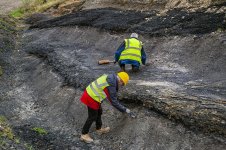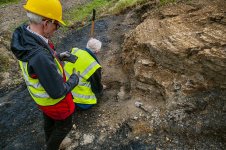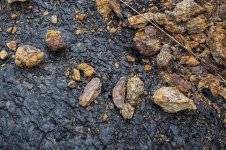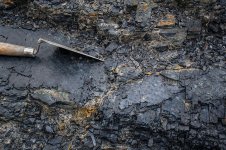Compared to wood, peat or lignite coal is very high in carbon, especially the steam coals...
The marine cycles were driven by changes in sea level and land level due to many factors, such as glaciation compaction and tectonic uplift and downthrow.
Typically a sequence would run from deepwater fine muds, through fine silts and sands to coarse deltaic sands and even gravels, to a soil or seat earth followed by a coal. For whatever reason the sea would return and a marine band with seashells be formed and a repeat of the sequence. The sediment indicates a deep water basin into which a delta progresses, breaks surface and is colonised with vegetation, followed by immersion and repeat. The marine bands contain both long lived species typical of the environment and short lived species that date each incursion. Examination of the coal reveals a fine detail of plant debris containing leaves, twigs, seeds and pollen in various states of thermal alteration from low grade metamorphism. Gas, rather than oil may be produced and migrate to hydrocarbon traps, leaving the dense high carbon coals.
Some theories state that the coal swamps were subject to extreme seasonal variation, so that summer abundance turned into deciduous drifts of leaves etc that couldnt be decomposed by detritivore organisms in a cold "arctic" winter. Repeat over countless years to produce deep organic deposits that become coalified.
In modern forests the fall of debris is usually consumed and recycled seasonally without a build up, but the coal beds represent years of accumulation. Often quoted is the deltaic swamp of Okefenokee Swamp as a "coal measure type" feature, but it seems that not enough organic detritus is being built up?







